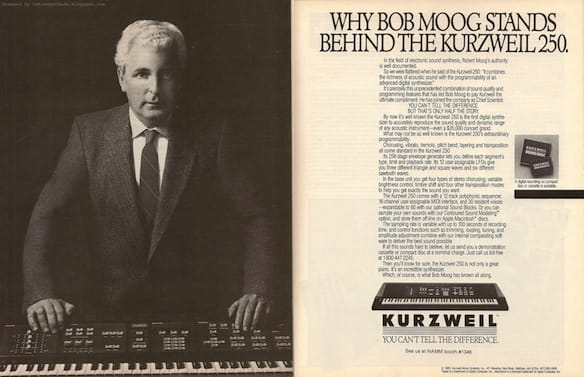
Image credit: Retro Synth Ads.
These Notes Are Made for Walking
By Valerie Farabee
An acoustic piano is an instrument with a beautiful look and sound, particularly when played under the right conditions by a person who knows what he or she is doing! It is also a cumbersome, finicky instrument requiring an absurd amount of maintenance and a high level of attention. For the purpose of this buying guide we will assume that you are looking for an affordable, portable, starter replacement for the mighty acoustic piano, and in this I introduce you to the electronic keyboard and the digital piano. An electronic keyboard or digital piano provides a less costly, handy way to learn the piano without having to pony up – or find space – for a large acoustic piano.
Tickle the Keys to Your Heart
A musical keyboard is a set of adjacent depressible levers or keys on a musical instrument, particularly an acoustic piano. Pressing a key on the keyboard causes the instrument to make sounds utilizing different strategies based on the type of instrument it is. Electronic keyboards make a sound when a key connected to a circuit is depressed. Instead of playing notes made up of sound vibrations and wood resonance, you connect to pre-recorded digital files of the same note.
The difference between a digital piano and an electronic keyboard is that a digital piano is designed to mimic the feel of an acoustic piano, and as such it has 88 keys weighted to feel like a piano’s keys and the sounds are sampled using amplifiers and speakers rather than the hammers and strings found in a piano. An electronic keyboard is very similar to a digital piano but does not have the weighted keys, the sound is generated through a synthesizer, and may come with either 49 or 61 keys, as opposed to the piano’s traditional 88. Although you will certainly be able to learn on keyboards with as few as 25 keys, in order to avoid constant upgrading and frustration, I recommend you start with an instrument that has at least 61 keys.
Lights? Camera? Action?
Action refers to the feel of the board underneath your fingers. In acoustic pianos, the weight of the key is a result of a felted hammer hitting a metal string. There is no sensation of weight when pressing down a key on an electronic board because there are no hammers or strings to weight the keys down. When choosing a keyboard, bang around on the keys for a bit to determine your preferred weight. Weighted and semi-weighted keys have the feel of a traditional piano. Graded or hammer action keys use a hammer mechanism to recreate the feel of grand piano. Synth action keys use springs for a lighter, faster action reminiscent of an organ. Unweighted keys are traditionally found on the less expensive keyboards.
If your hands feel stiff and sore after playing for awhile, it is likely that the action is too light and you should move on to a keyboard with weighted action.
The Sound of Music
After you’ve decided on a keyboard and determined your preferred key weight, it’s time to listen to the sound of music! Even as a beginner, you can listen for these few basic qualities in the sound and know if the instrument you’re playing is right for you:
Do the notes resonate and decay naturally? Does it sound like a piano?
Do the bass notes sound appropriately deep and thunderous?
Are the high notes crystal clear and sparkly, or are they dull and muted?
How do you like the sound after considering the above features? If you think you’ve found a keyboard with the right tone and the right feel for your playing objectives, it’s time to look at the companion accessories you need to start!
All the Bells & Whistles
Of course, pianos do not usually come with either bells or whistles. Luckily there aren’t too many different accessories you’ll need when you start playing the keyboard, but you will definitely need:
A stand. Are you going to sit on the floor and play? I didn’t think so. If the stand doesn’t come with the keyboard, make sure to ask a trusted salesperson to recommend one for you, and don’t leave the store without it!
A piano stool. C’mon, you don’t want to play standing up all the time, do you? Grab a piano bench, stool, or other seating accessory and make sure it is the right height for your stand.
Keyboard speakers. While digital pianos almost always come with built-in speakers, the less expensive keyboards might not. Find out at the store and make sure to get a set if your choice of instrument does not come with them.
Those are the basic starter accessories needed to begin tickling the keys, so be sure to factor them into the total cost of the instrument.
What’s the Damage?
Electronic keyboards can range from the low-end at $100 to the high end, weighted action, digital pianos for $3,000 or more. I always recommend buying the best quality that you can afford at the time, no matter what! You can find a good portable keyboard set with a stand and stool for under $200. The keys will not be weighted and the sound might be tinny, but you can get started! For the more serious player, a keyboard set in the $600 – $700 range will get you through high school, college, and your first performances without holding you back. A great digital piano for the career and studio players can cost as little as $1500 or more than $3,000! Beginners, stay away from the high end and choose the best you can afford when you are buying it, and make sure you have decided to stick with it before buying one of the more expensive sets.
Good luck on your musical journey!



